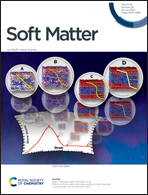Slip and momentum transfer mechanisms mediated by Janus rods at polymer interfaces†
Abstract
As an incipient but preeminent technology for multiphase nanomaterials/fluids, exact compatibilizing mechanisms of Janus particles in polymer blends and the consequent morphology remain unknown. The contributions of Janus nanorods to slip suppression and momentum transfer across the interface have been explored through dissipative particle dynamics simulations under shear flow at unentangled polymer–polymer interfaces. Rods have been then grafted with flexible polymer chains to unveil interfacial structure–property relationships at a molecular level when compared with flexible diblock copolymer surfactants. When Janus rods are sparsely grafted with necessarily longer grafts, they favor a greater degree of graft interpenetration with polymer phases. This yields less effective momentum transfer that impacts droplet coalescence processes; dynamic heterogeneities at complex interfaces; and helps map their efficiency as compatibilizers.



 Please wait while we load your content...
Please wait while we load your content...
